Last updated: October 21, 2022
Article
Designing a Water System for the Future
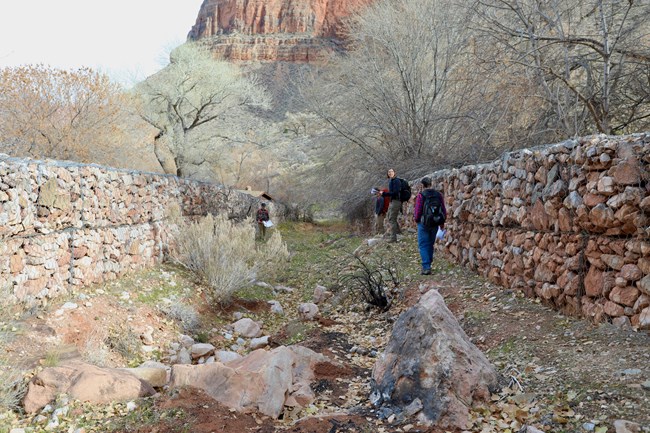
NPS photo.
By Lily Daniels
March 3, 2022
On a mid-afternoon Thursday in January, the sun’s warm rays beckon hikers trekking along the inner canyon trails at Grand Canyon National Park. Amongst some visitors seeking a break from the Bright Angel Trail at Indian Garden is a group of uniformed park rangers, National Park Service (NPS) staff and civilian engineers passing around blueprints and taking notes, a scene that encourages a pair of hikers to stop and inquire about a necessity they all require – water.
The curious hikers have inquired about a break in the park’s waterline and are seeking information about the progress of the repair and available water sources. Coincidentally, they have encountered a group conducting a final site visit to wrap up design plans for the Transcanyon Water Distribution Pipeline, commonly known as the Transcanyon Waterline (TCWL) program.

NPS Photo.
Park rangers from the group stop to answer questions and assure the hikers a repair crew from the park’s facilities and maintenance division is nearly done repairing the leak that occurred further down the waterline.
Many residents are familiar with the aged waterline’s multiple annual breaks which interrupts the flow of water, on average for three to five days, through the inner canyon to the South Rim. The breaks require visitors, residents, and commercial operators to implement increasing levels of water conservation measures, but there’s good news. The TCWL is coming.
Don’t let the title of the TCWL program mislead you into thinking its only swapping out some sections of pipe at Grand Canyon National Park. It isn’t. The program is the overall modernization of the water delivery system and associated infrastructure.
“For years, the park has needed a more secure water system and this project will allow us certainty and resiliency in our water delivery and distribution systems,” said Grand Canyon National Park Superintendent Ed Keable.
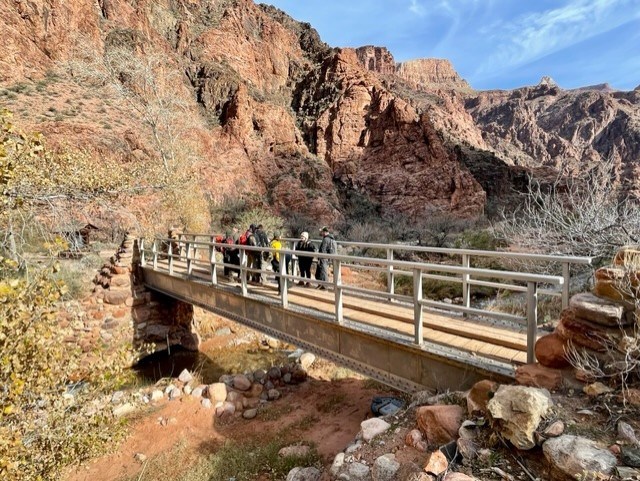
NPS Photo.
The site visit, conducted by NPS staff members and an architectural and engineering firm is the culmination of final design review workshops and coordination sessions hosted at the park with representatives from the Arizona Department of Environmental Quality (ADEQ), Arizona Public Service (APS), commercial operators, and various NPS project managers and Grand Canyon program leads.
The review comes after 10 years of tests, analyses, reviews and much coordination in the process to meet public health, state and federal standards, environmental laws, and historic and NPS resource management policies.
“One of the challenges the design team faced was the balance in developing an infrastructure design solution that provides reliable, safe drinking water and power, while balancing environment, social and economic elements, said NPS Civil Engineer Chris Carpenter, the NPS portfolio manager for the TCWL program. “We worked with an integrated interdisciplinary team within the NPS comprised of utilities operators, engineers, natural and cultural resource managers, protection rangers, public affairs, public health officers and management, along with exterior stakeholders such as regulatory authority for potable water systems like the ADEQ, APS, U.S. Army Corps of Engineers and the commercial operators within the park, to provide the design team with different perspectives that contributed to a best values approach to decision making.”
With the design stage nearing completion, the NPS is anticipating awarding a construction contract for the TCWL program later in the year. While specifics related to the construction schedule, scope, and impacts to commercial and visitor services will be determined after a contract is awarded, an overview of the TCWL program is available.
What is the TCWL program?
The TCWL program is the modernization of the more than 50-year-old waterline as well as the complex water delivery system to the South Rim and inner canyon. The project will provide an upgraded water delivery system and meet the water service needs at the South Rim and Cross Canyon Corridor for the next 50 plus years. The TCWL program includes:
- Replacing approximately 3 miles of pipe from Phantom Ranch to Indian Garden (soon to be renamed Havasupai Gardens)
- Replacing the water distribution at Indian Garden
- Replacing the water and electrical distribution at Phantom Ranch
- Constructing a water intake system and pumping station at Phantom Ranch
- Upgrading approximately 3 miles of electrical supply line from Indian Garden to Phantom Ranch
- Constructing a water treatment plant at the South Rim and a smaller water treatment plant at Phantom Ranch
With the scale of construction coming to the park, there’s also going to be an increase in contractor support facilities included to facilitate the program. Upgrades to the park helibase will be one of the first project components in the construction sequencing. An auxiliary hangar and helicopter landing pad will be constructed to maintain routine and emergency park operations throughout the duration of the program as well as a contractor support area with trailer hookups, parking and staging areas.

NPS Photo.
TCWL Improvements
Constructed in the 1960s, the 12.5-mile long TCWL has exceeded its projected 30-year design life. The NPS performed a comprehensive condition assessment of the existing waterline during fiscal year 2014, and the assessment along with previous corrosion studies indicated the waterline needs to be replaced.
The original TCWL pipe material is aluminum, which contributes to the degradation of the waterline and frequent structural breaks. A break typically runs longitudinally with the pipe and repairing it usually consists of cutting out and replacing an 8-foot section of aluminum pipe. One of the primary reasons the water system utilizes aluminum pipe in the inner canyon is its weight to size ratio that makes it easier to haul in the pipe.
“The tradeoff with using lighter aluminum pipe is the reduction in structural integrity to resist the high-pressure zones within the system,” added Carpenter. “Most water delivery systems in the country consist of pipe materials predominantly composed of cast iron, ductile iron, cement or polyvinyl chloride.”
On average, the TCWL experiences at least one waterline break a month that Grand Canyon National Park responds to via trail or helicopter, costing approximately $25,000 to repair a single break. During a break, inner canyon facilities north of Phantom Ranch have no potable water, and Phantom Ranch, Indian Garden and the South Rim become dependent on stored water.
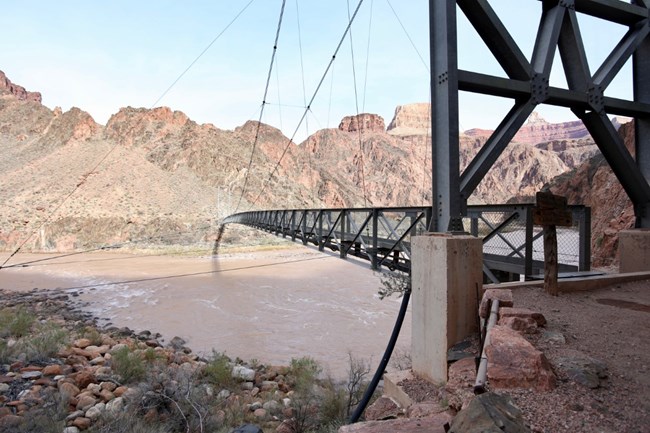
NPS Photo.
“Our staff have become good at addressing the health and safety concerns for both staff and visitors during these waterline breaks. We are looking forward to a time when breaks are a rarity rather than the norm,” said Keable.
In its current design, gravity plays a major role in the functioning of the waterline, creating sufficient pressure to flow water to Indian Garden from Roaring Springs. From an elevation of 5,200 feet, water travels down along the North Kaibab Trail in the waterline, through Phantom Ranch. It crosses the Colorado River and reaches its lowest elevation of 2,400 feet before it ascends the canyon and enters the Indian Garden pump houses at an elevation of 3,700 feet. From Indian Garden, water is pumped up 3,300 feet in elevation to the South Rim through the borehole section of the waterline.
The current water intake is located at Roaring Springs and carries about 190 million gallons of drinking water via the TCWL to over 6 million visitors and 2,500 residents at the Inner Canyon Corridor and South Rim developed area.
“There are complex and diverse construction constraints in the inner canyon that includes vastly diverse topography, weather, natural and cultural resources, visitor experiences, safety considerations, business opportunities and park operations,” said Carpenter. “We’ve integrated unique materials, equipment and design strategies to allow for some of the most challenging logistics where most of the materials and equipment must be flown in by helicopter into remote work areas with limited communications and services to support sustained construction operations.”
The NPS has developed an engineering design to overcome the challenges of replacing the entire TCWL. Many engineering studies were completed in conjunction with public health and ADEQ reviews to analyze the most resilient water source that would meet water quality and quantity for the system while also minimizing impacts to natural and cultural resources.
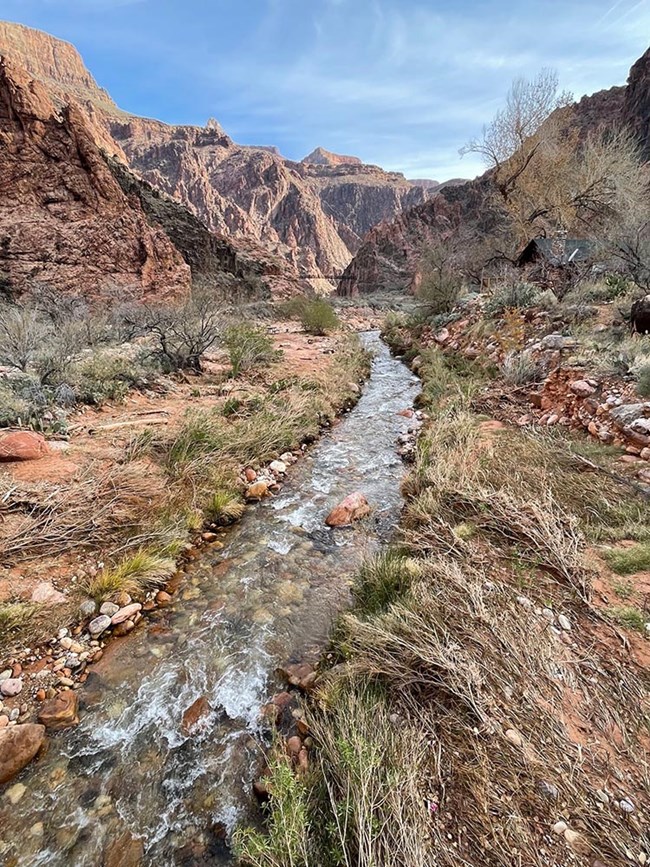
NPS Photo.
The studies and design process has resulted in a decision that relocates the water intake to Bright Angel Creek near Phantom Ranch. This will create a second water source for the park with the South Rim, Indian Garden and Phantom Ranch receiving water from the new intake at Bright Angel Creek while Roaring Springs will continue to provide water to the North Rim, Manzanita and Cottonwood.
Moving the water source to Bright Angel Creek will enable additional streams and watersheds to feed into the water intake and provide more resiliency for future water conditions. The location will also reduce the pipe length and eliminate the portion of the current waterline that experiences the most frequent failures, an area north of Phantom Ranch known as “The Box”. The new waterline will stretch nearly 3 miles from Phantom Ranch to Indian Garden. With this design, natural flow would be restored to Bright Angel Creek from Roaring Springs.
An interdisciplinary team of NPS engineers, engineering consultants and U.S. Public Health officers analyzed many types of industry standard pipe materials for potable water systems as well as less common materials that have lower weight to size ratios to replace the water distribution system.
“The team selected flex-steel pipe because of the balanced tradeoff between weight to durability and the strength of the material,” said Carpenter. “The complexity of the inner canyon’s access and environmental conditions has made the selection of materials and equipment absolutely critical in balancing design and constructability while mitigating the impact to cultural and natural resources.”
Approximately 18,000 feet of 6-inch aluminum pipe will be replaced between Indian Garden and Phantom Ranch with 8-inch flex-steel pipe. Water distribution improvements at Indian Garden include replacing the distribution pipe, water stations and fire standpipes. Water distribution improvements along the Bright Angel Trail will also be completed at the Mile-and-a-Half and Three-Mile Rest Houses.
Due to the relocation of the water intake, the water system requires a small water treatment plant, pump station and raw water tank at Phantom Ranch to provide water for the approximately 80,000 Phantom visitors plus staff who consume about 4.1 to 4.5 million gallons annually. A 1 million-gallon per day water treatment plant will be constructed on the South Rim to provide water to the South Rim, Mile-and-a-Half Rest House, Three-Mile Rest House and Indian Garden.
The Phantom Ranch water treatment plant will also include improved water pressure compared to the current system to support structural fire suppression for the sprinkler systems and fire standpipes at the Phantom Ranch developed area.
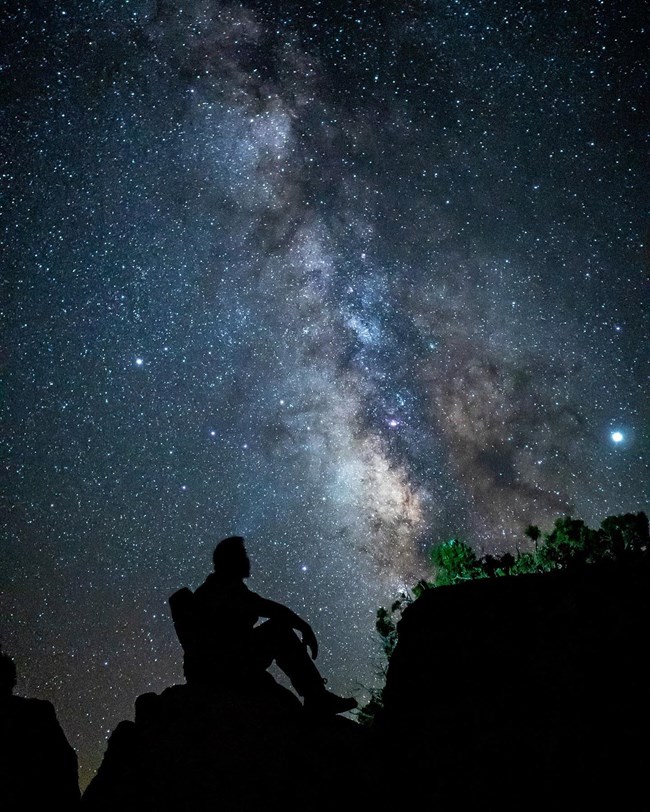
NPS Photo by Ty Karlovetz.
The upgraded TCWL facilities and associated infrastructure design elements also coordinate with other park initiatives. The facilities meet International Dark Sky building standards to retain the park’s International Dark Sky Park status and visitor experience. The materials selected also contribute to the overall design aesthetic enabling them to blend with existing historical structures as well as the landscape to minimize the impact of their appearance within the natural surroundings.
“Our staff has worked diligently over the past 10 years to ensure that the designs were compatible with the historic nature of the trail and took into account the unique cultural, natural and experiential resources of the canyon,” said Keable.
The TCWL program planning efforts are being coordinated so they sequence with other park project activities, enabling the interconnected systems to be brought online at the right time. The NPS is beginning construction of the TCWL with staging, logistical support, and water treatment facilities on the South Rim in late 2022 and inner-canyon construction of the waterline and additional facilities beginning in 2023. The NPS expects the replacement of the TCWL to be finished in 2027.
